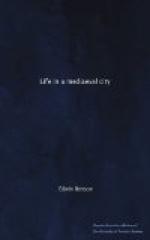While the trade-guilds were thus responsible for individual pageants, help and control were given by the Guild of Corpus Christi (inaugurated in 1408 and incorporated in 1459), and the city council. The guild had a very large number of members, among whom were the Archbishop, many bishops and abbots and nobles. These dramatic productions belonged to the religious and social sides of the guilds. The plays, however, did not always provoke pleasure, for sometimes members of some of the guilds complained of the financial burden they were forced to bear in order to produce the plays allotted to them.
The guilds also took part in public processions with torches on Corpus Christi Day in celebration of this popular festival. In the processions, which were closely connected with the religious and guild-phases of city life, there walked city clergy wearing their surplices, the master of the Guild of Corpus Christi, the guild officials, the bearers of the shrine of the guild, the mayor, aldermen and corporation, and officers and members of the Guild of Corpus Christi and of the city trade-guilds. As the procession went on its way litanies and chants were sung by the clergy. The shrine, the central feature of the procession, was presented in 1449. It was itself of gilt and had many images some of which were gilded, while the main ones under the “steeple” were in mother-of-pearl, silver, and gold: to it were attached rings, brooches, girdles, buckles, beads, gawds and crucifixes, in gold and silver, and adorned with coral and jewels.
On the occasion of the processions and performances of pageants, as at fairs, the city was filled with a boisterous multitude which turned what was by tradition a religious exercise and entertainment, to a time of riotous merry-making, and uncouth disorder. In 1426 a kind of crusade was preached by a friar minor, William Melton, against the riotous and drunken conduct of the people at the Corpus Christi festival. He denounced the disgracing of the festival and affirmed that the people were forfeiting by their conduct the indulgences granted for the festival. The result of the friar’s crusade was the holding of a special meeting of the city council, which decided that the processions and pageants were to be held on separate days, the pageants on the eve of Corpus Christi, and the procession on the feast itself. Formerly both had taken place on the same day.
The pageants were produced in suitable parts of the city. Stages on wheels were brought to these places, some of them open spaces, others main streets. The stages, which were the work of citizen workmen, were of three storeys, the central and principal one, the stage proper, representing the earth. Demons, in gaudy attire, came up from the flame-region of the lowest storey; divine messengers and personages came down from the star and cloud adorned tipper storey. The tiring-room was below and behind the stage. The acting was by members of the guilds. They, no doubt, practised here, as elsewhere, the ranting delivery of their speeches so denounced by Hamlet in his critical address to the Players, whom he admonished to speak “trippingly on the tongue” and not to “out-Herod Herod.” There are several references in Shakespeare to these plays of the Middle Ages. For instance, in Twelfth Night:




